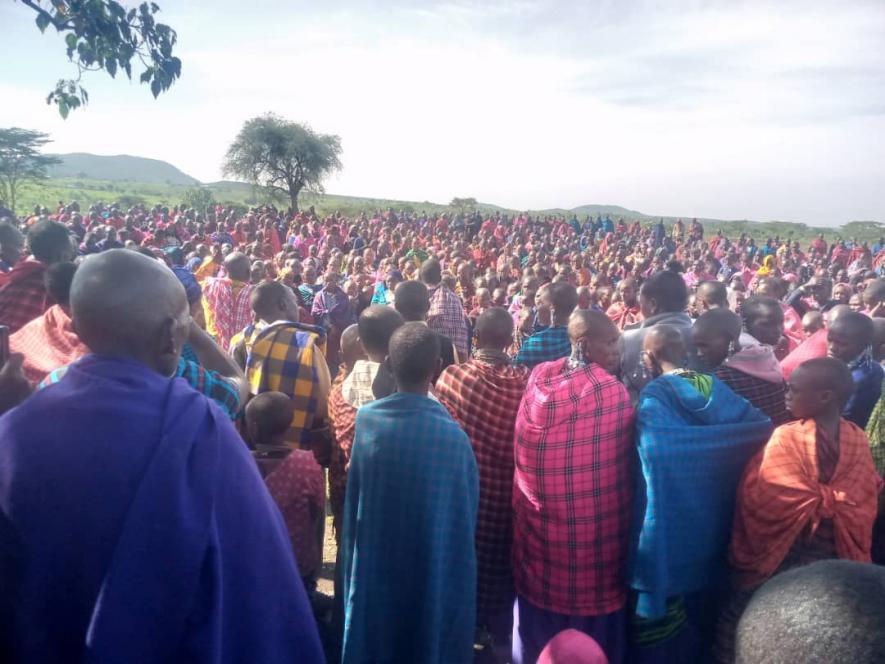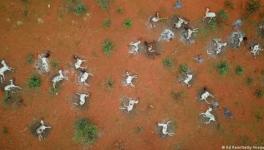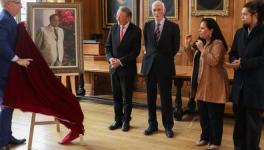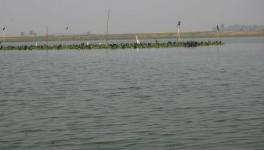Maasai Displacement: One arm of UN ‘Undoing’ Work of Other

The Tanzanian government plans to displace more than 1,50,000 Maasai herders from the 8,000 sq km Ngorongoro Conservation Area World Heritage property under the guise of conservation and tourism promotion. Besides, the government intends to acquire 1,500 sq km of dry grazing land in the nearby Loliondo region.
The Maasais, who have decided not to vacate the land alleging that the government’s plan will promote trophy hunting and elite tourism, blocked the entrance to the site in a series of protests in February. They have also petitioned tourism companies to pause their projects until the eviction plan is dropped.
Protestors in London demanded an official response from the Tanzanian High Commission to their demand of stopping the eviction. There are calls to boycott tourism in these parts of Tanzania until the matter is resolved.
A press statement released after the London protest quoted a traditional Maasai leader: “Imagine your home is burned in front of you to clear your land for foreigners to hunt. Imagine not being able to graze our cows as we have done for millennia because of the restrictions imposed by the government to protect a foreign company that is only hunting the wildlife.”
The government plan flies in the face of the United Nations Declaration of the Rights of Indigenous Peoples (UNNDRIP), adopted by the General Assembly in 2007. Although UNDRIP is a legally non-binding resolution, it obliges states to protect the individual and collective rights of indigenous peoples.
“We are visiting the UK companies undertaking business in the Ngorongoro district and inviting them to join the international community in protecting human rights. This is a chance for travel agencies to signal to their customers and the wider public that they take their social responsibility obligations seriously and stand by the Maasai communities, who safeguard the lands,” said Paola Hernandez, who was part of the London protest.
In the 1940s, when fertile lands between Mount Meru and Mount Kilimanjaro were taken over as wildlife reserves, the Maasai pastoralists faced displacement. The Maasai have continued to demand grazing rights in wildlife reserves and resisted attempts to give up pastoralism and lead a sedentary life.
The Maasai Mara ecosystem of the African savanna remains among the best-conserved grasslands in the world and the credit for this conservation success goes to the cultural traditions of the Maasai, whose lifestyle has led to stability in the population of large mammals like lions, cheetahs and leopards.
Ecologist Dr S Faizi from Thiruvananthapuram, Kerala, has written to the UNSECO director general seeking delisting of the area as a world heritage site if the Tanzanian government goes ahead with the eviction plan. Faizi argued that alienating traditional resource managers from their land is a cause of the massive extinction of species, including in the Fifth Global Biodiversity Assessment Report of the Convention on Biological Diversity.
“Returning the power of biodiversity management to the indigenous people and local communities will make the conservation project successful and decrease the widening poverty in biodiversity-rich areas,” Faizi wrote.
Faizi pointed out that the world heritage centre too must have a technical advisory body like any environmental treaty. Criticising the exclusion of the Global South from decision-making in nature conservation, he wrote: “IUCN (International Union for Conservation of Nature), with which I am familiar since the mid-1980s as head of its de facto youth wing, never had a director general from the global South in its 75 years of existence, which glaringly reflects its politics.”
Mentioning how IUCN’s conservation “doctrine of ‘islands conservation areas’ is rooted in the colonial notion”, Faizi wrote: “Some of the architects of this doctrine carry the legacy of zoos displaying humans abducted from Africa and some even carry the legacy of the trans-Atlantic slave trade”.
The set of draft articles IUCN/ELC (Environmental Law Centre) presented to the Intergovernmental Negotiation Committee on CBD “were so regressive that the global South had to completely discard them in order to create a progressive CBD. I am one of the negotiators who did that”, Faizi further wrote.
“Unesco has no reason to be statutorily associated with such a body when the WHC can establish its own advisory body, removing IUCN and ICOMOS (International Council on Monuments and Sites) from advisory status. Remember, it is these bodies that are largely responsible for the overcrowding of Western Europe with WH properties, making the list a skewed one, far removed from being representative of the real world. Being a multilateral body, ICCROM (International Centre for the Study of the Preservation and Restoration of Cultural Property), the third organisation mentioned in the Operational Guidelines, can be retained in a special relationship,” Faizi suggested.
Faizi further suggested that the 1972 World Heritage Convention and its operational guidelines should be modernised so these are in sync with UNDRIP. “There are at present several provisions that are in breach of UNDRIP and inconsistent with the Convention on Biological Diversity.”
The writer is a freelance journalist.
Get the latest reports & analysis with people's perspective on Protests, movements & deep analytical videos, discussions of the current affairs in your Telegram app. Subscribe to NewsClick's Telegram channel & get Real-Time updates on stories, as they get published on our website.
























